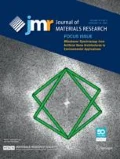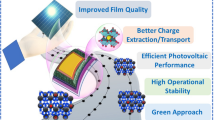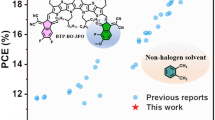Abstract
Two kinds of type-II heterostructures (HSs) of ZnO (wurtzite)/ZnSe (wurtzite) [ZnO (WZ)/ZnSe (WZ)] and ZnO (wurtzite)/ZnSe (zinc blende) [ZnO (WZ)/ZnSe (ZB)] were designed for photovoltaic applications by first-principle calculations. The calculated effective bandgap of 1.51 eV for the ZnO (WZ)/ZnSe (WZ) HS is more favorable for solar cell applications compared to that of 1.69 eV for the ZnO (WZ)/ZnSe (ZB) HS. Furthermore, the electrons and holes are more effectively separated at the interface of ZnO (WZ)/ZnSe (WZ) HS due to the stronger misfit stress field. Finally, a strained ZB ZnSe layer was introduced to transport the separated holes from WZ ZnSe layer, and an optimal structure of ZnO (WZ)/ZnSe (WZ)/ZnSe (ZB) was proposed to realize a solar cell with near-infrared response.




Similar content being viewed by others
REFERENCES
K.L. Chopra, P.D. Paulson, and V. Dutta: Thin-film solar cells: An overview. Prog. Photovoltaics Res. Appl. 12, 69 (2004).
R.R. King, D.C. Law, K.M. Edmondson, C.M. Fetzer, G.S. Kinsey, H. Yoon, R.A. Sherif, and N.H. Karam: 40% efficient metamorphic GaInP/GaInAs/Ge multijunction solar cells. Appl. Phys. Lett. 90, 183516 (2007).
W.J.E. Beek, M.M. Wienk, and R.A.J. Janssen: Efficient hybrid solar cells from zinc oxide nanoparticles and a conjugated polymer. Adv. Mater. 16, 1009 (2004).
M. Grätzel: Photoelectrochemical cells. Nature 414, 338 (2001).
B.M. Kayes, H.A. Atwater, and N.S. Lewis: Comparison of the device physics principles of planar and radial p-n junction nanorod solar cells. J. Appl. Phys. 97, 114302 (2005).
Y. Zhang, L. Wang, and A. Mascarenhas: “Quantum coaxial cables” for solar energy harvesting. Nano Lett. 7, 1264 (2007).
J. Schrier, D.O. Demchenko, L.W. Wang, and A.P. Alivisatos: Optical properties of ZnO/ZnS and ZnO/ZnTe heterostructures for photovoltaic applications. Nano Lett. 7, 2377 (2007).
K. Wang, J.J. Chen, W.L. Zhou, Y. Zhang, Y.F. Yan, J. Pern, and A. Mascarenhas: Direct growth of highly mismatched type-II ZnO/ZnSe core/shell nanowire arrays on transparent conducting oxide substrates for solar cell applications. Adv. Mater. 20, 3248 (2008).
W. Shockley and H.J. Queisser: Detailed balance limit of efficiency of p-n junction solar cells. J. Appl. Phys. 32, 510 (1961).
Z.M. Wu, Y. Zhang, J.J. Zheng, X.G. Lin, X.H. Chen, B.W. Huang, H.Q. Wang, K. Huang, S.P. Li, and J.Y. Kang: An all-inorganic type-II heterojunction array with nearly full solar spectral response based on ZnO/ZnSe core/shell nanowires. J. Mater. Chem. 21, 6020 (2011).
G. Kresse and J. Furthmuller: Efficient iterative schemes for ab initio total-energy calculations using a plane-wave basis set. Phys. Rev. B 54, 11169 (1996).
G. Kresse and J. Furthmuller: Efficiency of ab-initio total energy calculations for metals and semiconductors using a plane-wave basis set. Comput. Mater. Sci. 6, 15 (1996).
G. Kresse and D. Joubert: From ultrasoft pseudopotentials to the projector augmented-wave method. Phys. Rev. B 59, 1758 (1999).
P.E. Blöchl: Projector augmented-wave method. Phys. Rev. B 50, 7953 (1994).
J.P. Perdew and Y. Wang: Accurate and simple analytic representation of the electron-gas correlation energy. Phys. Rev. B 45, 13244 (1992).
H.J. Monkhorst and J.D. Pack: Special points for Brillouin-zone integrations. Phys. Rev. B 13, 5188 (1976).
X.M. Cheng and C.L. Chien: Magnetic properties of epitaxial Mn-doped ZnO thin films. J. Appl. Phys. 93, 7876 (2003).
C.G. Van de Walle and R.M. Martin: Theoretical calculations of heterojunction discontinuities in the Si/Ge system. Phys. Rev. B 34, 5621 (1986).
M. Peressi, N. Binggeli, and A. Baldereschi: Band engineering at interfaces: Theory and numerical experiments. J. Phys. D: Appl. Phys. 31, 1273 (1998).
J.J. Zheng, Z.M. Wu, W.H. Yang, S.P. Li, and J.Y. Kang: Growth and characterization of type-II ZnO/ZnSe core/shell nanowire arrays. J. Mater. Res. 25, 1272 (2010).
Y. Zhang, K.H. Cai, C. Li, S.Y. Chen, H.K. Lai, and J.Y. Kang: Strain relaxation in ultrathin SGOI substrates fabricated by multistep Ge condensation method. Appl. Surf. Sci. 255, 3701 (2009).
ACKNOWLEDGMENTS
The work was supported by “973” Program (2011CB925600), the National Natural Science Foundations of China (60827004, 61106008, 61106118, and 90921002), the Natural Science Foundations of Fujian Province (2010J01343 and 2011J01362), the fundamental research funds for the central universities (2011121042 and 2011121026), and the Science and Technology Programs of Fujian Province and Xiamen.
Author information
Authors and Affiliations
Corresponding authors
Rights and permissions
About this article
Cite this article
Ni, J., Wu, Z., Lin, X. et al. Band engineering of type-II ZnO/ZnSe heterostructures for solar cell applications. Journal of Materials Research 27, 730–733 (2012). https://doi.org/10.1557/jmr.2011.417
Received:
Accepted:
Published:
Issue Date:
DOI: https://doi.org/10.1557/jmr.2011.417




